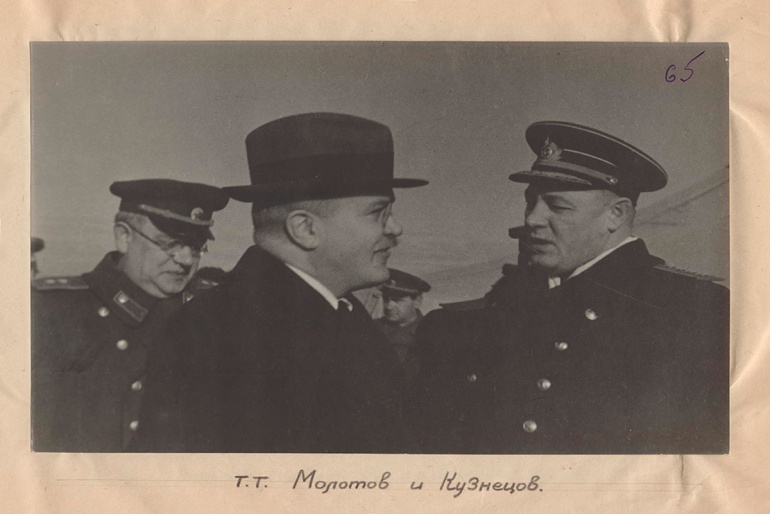EQUAL OPPORTUNITIES
The same standards apply to social equality in the USSR. Social background is not a factor in the fate of any Soviet citizen. Success comes to those with ability, diligence, vitality and a creative attitude towards work.Suppose a young worker (from a working-class family) decides to pursue a higher education. It is possible for him to do so without giving up his job by attending night school or enrolling in correspondence classes, both of which are free of charge. The administration at his work place has no right to prevent him from doing so. Furthermore, he is guaranteed by law certain privileges— additional paid leave during examination sessions and for writing his diploma paper. So, having received his diploma, this former worker becomes an engineer and continues to rise in the professional world.
In the Supreme Soviet of the USSR the majority of deputies are workers and collective farmers. The same is true of the Supreme Soviets of the Union and autonomous republics as well as of the local Soviets of People's Deputies — from those in the territories down to those in the villages. Taking into consideration the fact that there are over two million deputies in the local Soviets alone, one can well imagine how many workers and peasants get the practical experience of government management. Moreover, elections to the local Soviets take place every two and a half years, bringing in many new deputies.
Equality of men and women has become a reality. It is not just proclaimed in the Constitution — it is our everyday
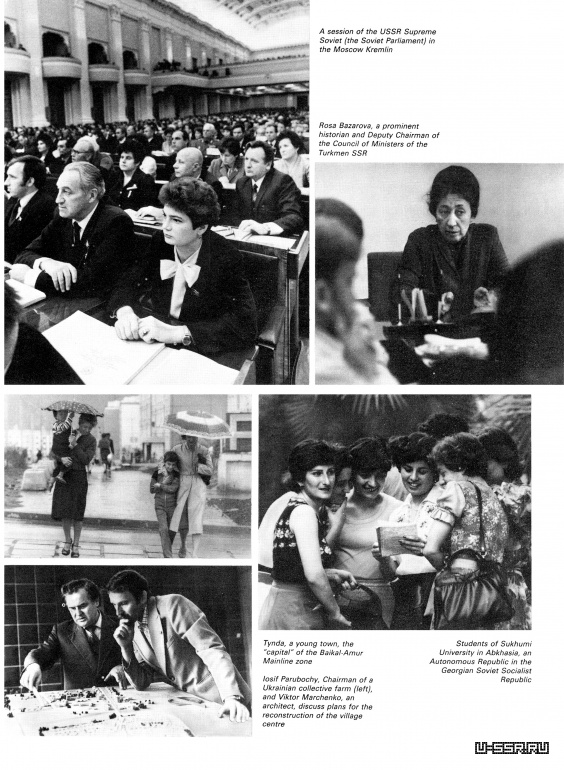
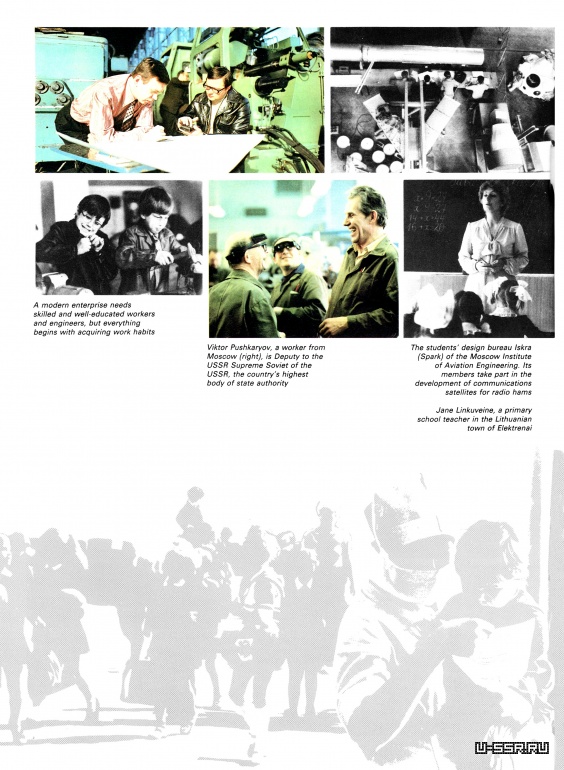
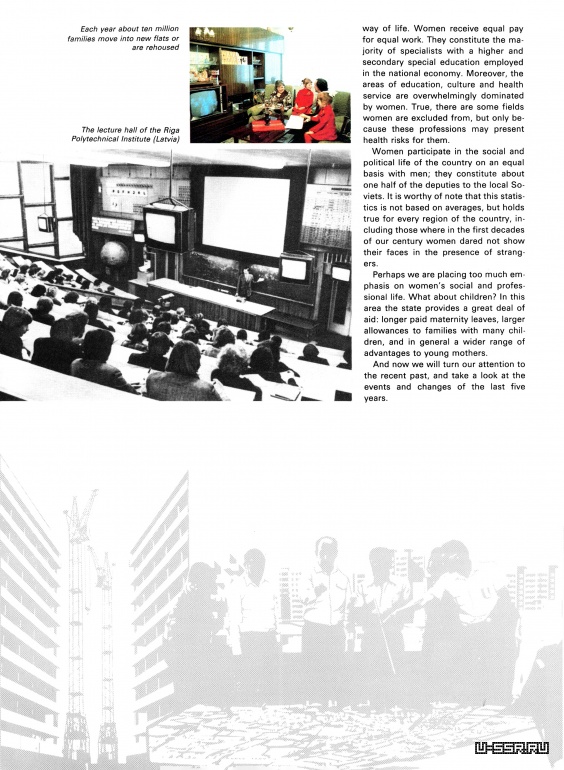
way of life. Women receive equal pay for equal work. They constitute the majority of specialists with a higher and secondary special education employed in the national economy. Moreover, the areas of education, culture and health service are overwhelmingly dominated by women. True, there are some fields women are excluded from, but only because these professions may present health risks for them.
Women participate in the social and political life of the country on an equal basis with men; they constitute about one half of the deputies to the local Soviets. It is worthy of note that this statistics is not based on averages, but holds true for every region of the country, including those where in the first decades of our century women dared not show their faces in the presence of strangers.
Perhaps we are placing too much emphasis on women's social and professional life. What about children? In this area the state provides a great deal of aid; longer paid maternity leaves, larger allowances to families with many children, and in general a wider range of advantages to young mothers.
And now we will turn our attention to the recent past, and take a look at the events and changes of the last five years.
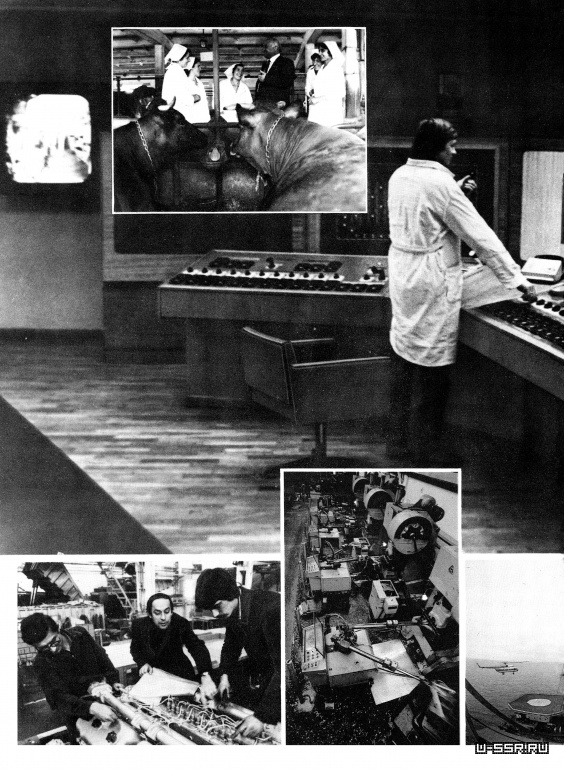
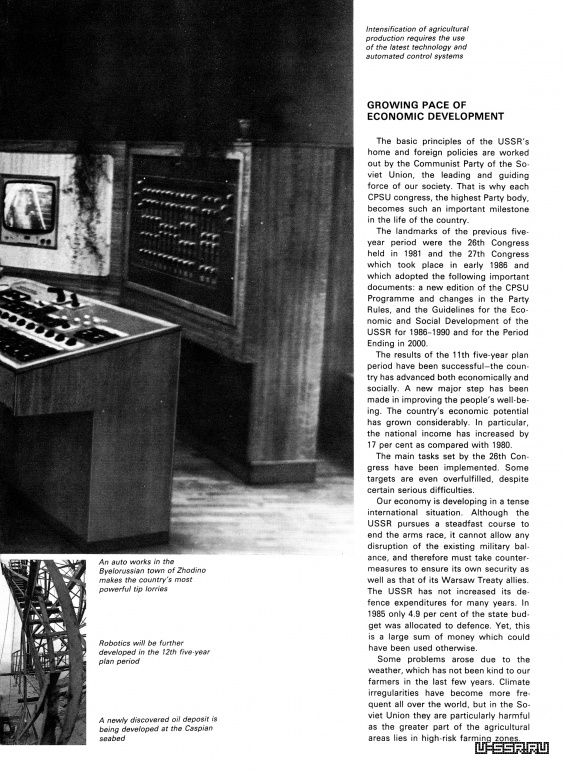
GROWING PACE OF ECONOMIC DEVELOPMENT
The basic principles of the USSR's home and foreign policies are worked out by the Communist Party of the Soviet Union, the leading and guiding force of our society. That is why each CPSU congress, the highest Party body, becomes such an important milestone in the life of the country.The landmarks of the previous five-year period were the 26th Congress held in 1981 and the 27th Congress which took place in early 1986 and which adopted the following important documents: a new edition of the CPSU Programme and changes in the Party Rules, and the Guidelines for the Economic and Social Development of the USSR for 1986-1990 and for the Period Ending in 2000.
The results of the 11th five-year plan period have been successful—the country has advanced both economically and socially. A new major step has been made in improving the people's well-being. The country's economic potential has grown considerably. In particular, the national income has increased by 17 per cent as compared with 1980.
The main tasks set by the 26th Congress have been implemented. Some targets are even overfulfilled, despite certain serious difficulties.
Our economy is developing in a tense international situation. Although the USSR pursues a steadfast course to end the arms race, it cannot allow any disruption of the existing military balance, and therefore must take countermeasures to ensure its own security as well as that of its Warsaw Treaty allies. The USSR has not increased its defence expenditures for many years. In 1985 only 4.9 per cent of the state budget was allocated to defence. Yet, this is a large sum of money which could have been used otherwise.
Some problems arose due to the weather, which has not been kind to our farmers in the last few years. Climate irregularities have become more frequent all over the world, but in the Soviet Union they are particularly harmful as the greater part of the agricultural areas lies in high-risk farming zones.
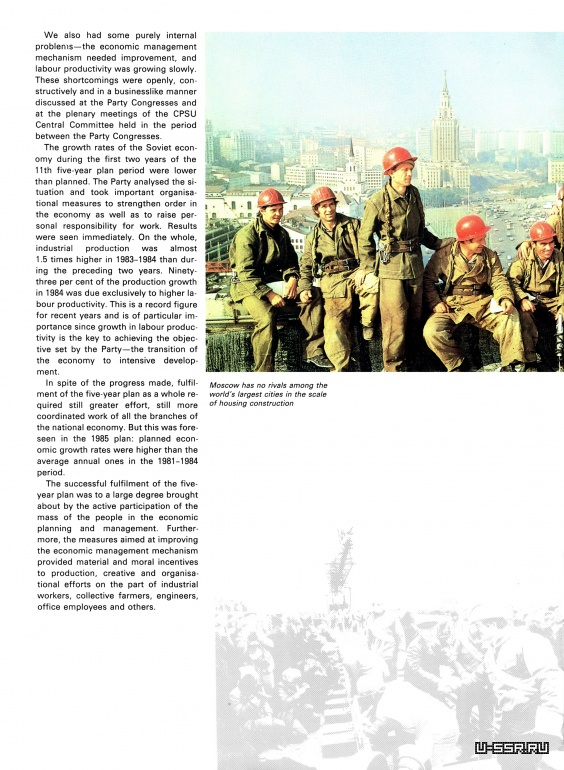
We also had some purely internal problems—the economic management mechanism needed improvement, and labour productivity was growing slowly. These shortcomings were openly, constructively and in a businesslike manner discussed at the Party Congresses and at the plenary meetings of the CPSU Central Committee held in the period between the Party Congresses.
The growth rates of the Soviet economy during the first two years of the 11th five-year plan period were lower than planned. The Party analysed the situation and took important organisational measures to strengthen order in the economy as well as to raise personal responsibility for work. Results were seen immediately. On the whole, industrial production was almost 1.5 times higher in 1983-1984 than during the preceding two years. Ninety-three per cent of the production growth in 1984 was due exclusively to higher labour productivity. This is a record figure for recent years and is of particular importance since growth in labour productivity is the key to achieving the objective set by the Party—the transition of the economy to intensive development.
In spite of the progress made, fulfilment of the five-year plan as a whole required still greater effort, still more coordinated work of all the branches of the national economy. But this was foreseen in the 1985 plan: planned economic growth rates were higher than the average annual ones in the 1981-1984 period.
The successful fulfilment of the five-year plan was to a large degree brought about by the active participation of the mass of the people in the economic planning and management. Furthermore, the measures aimed at improving the economic management mechanism provided material and moral incentives to production, creative and organisational efforts on the part of industrial workers, collective farmers, engineers, office employees and others.
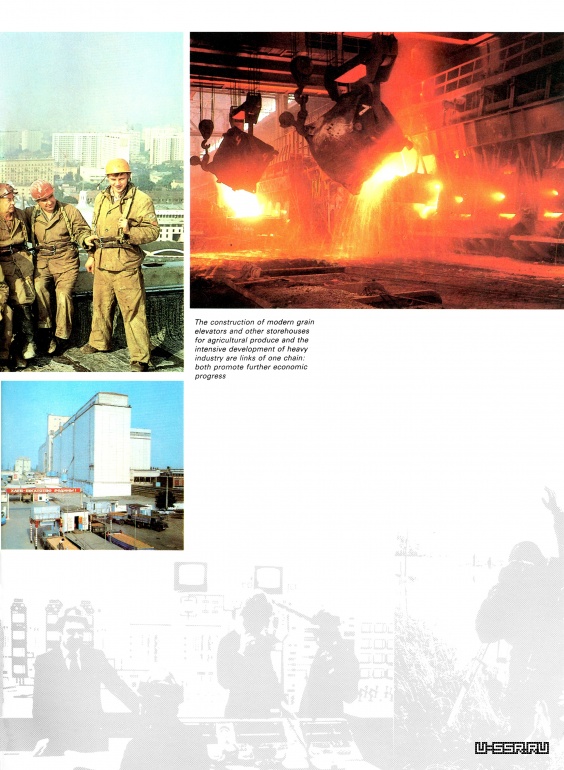
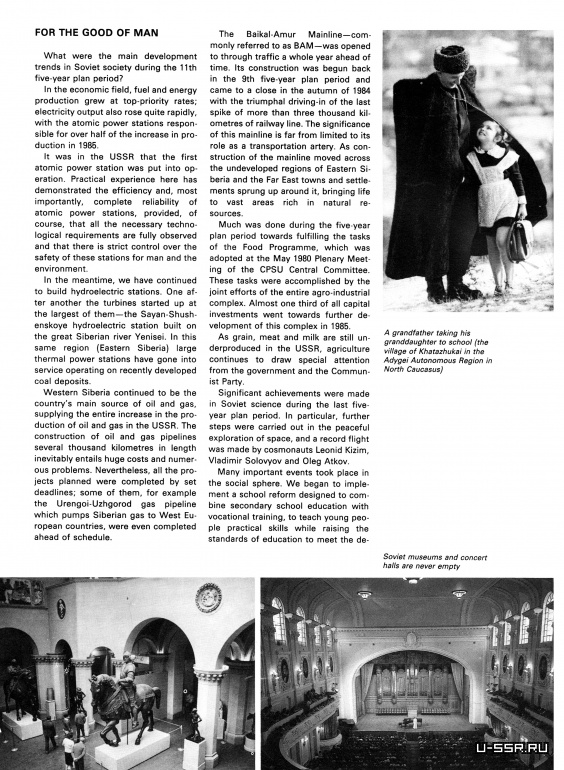
FOR THE GOOD OF MAN
What were the main development trends in Soviet society during the 11th five-year plan period?In the economic field, fuel and energy production grew at top-priority rates; electricity output also rose quite rapidly, with the atomic power stations responsible for over half of the increase in production in 1985.
It was in the USSR that the first atomic power station was put into operation. Practical experience here has demonstrated the efficiency and, most importantly, complete reliability of atomic power stations, provided, of course, that all the necessary technological requirements are fully observed and that there is strict control over the safety of these stations for man and the environment.
In the meantime, we have continued to build hydroelectric stations. One after another the turbines started up at the largest of them—the Sayan-Shush-enskoye hydroelectric station built on the great Siberian river Yenisei. In this same region (Eastern Siberia) large thermal power stations have gone into service operating on recently developed coal deposits.
Western Siberia continued to be the country's main source of oil and gas, supplying the entire increase in the production of oil and gas in the USSR. The construction of oil and gas pipelines several thousand kilometres in length inevitably entails huge costs and numerous problems. Nevertheless, all the projects planned were completed by set deadlines; some of them, for example the Urengoi-Uzhgorod gas pipeline which pumps Siberian gas to West European countries, were even completed ahead of schedule.
The Baikal-Amur Mainline—commonly referred to as BAM—was opened to through traffic a whole year ahead of time. Its construction was begun back in the 9th five-year plan period and came to a close in the autumn of 1984 with the triumphal driving-in of the last spike of more than three thousand kilometres of railway line. The significance of this mainline is far from limited to its role as a transportation artery. As construction of the mainline moved across the undeveloped regions of Eastern Siberia and the Far East towns and settlements sprung up around it, bringing life to vast areas rich in natural resources.
Much was done during the five-year plan period towards fulfilling the tasks of the Food Programme, which was adopted at the May 1980 Plenary Meeting of the CPSU Central Committee. These tasks were accomplished by the joint efforts of the entire agro-industrial complex. Almost one third of all capital investments went towards further development of this complex in 1985.
As grain, meat and milk are still underproduced in the USSR, agriculture continues to draw special attention from the government and the Communist Party.
Significant achievements were made in Soviet science during the last five-year plan period. In particular, further steps were carried out in the peaceful exploration of space, and a record flight was made by cosmonauts Leonid Kizim, Vladimir Solovyov and Oleg Atkov.
Many important events took place in the social sphere. We began to implement a school reform designed to combine secondary school education with vocational training, to teach young people practical skills while raising the standards of education to meet the de-
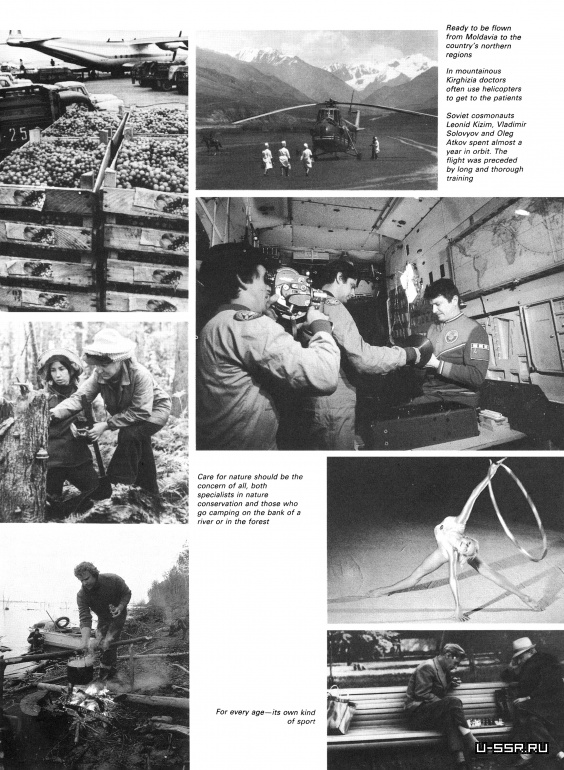
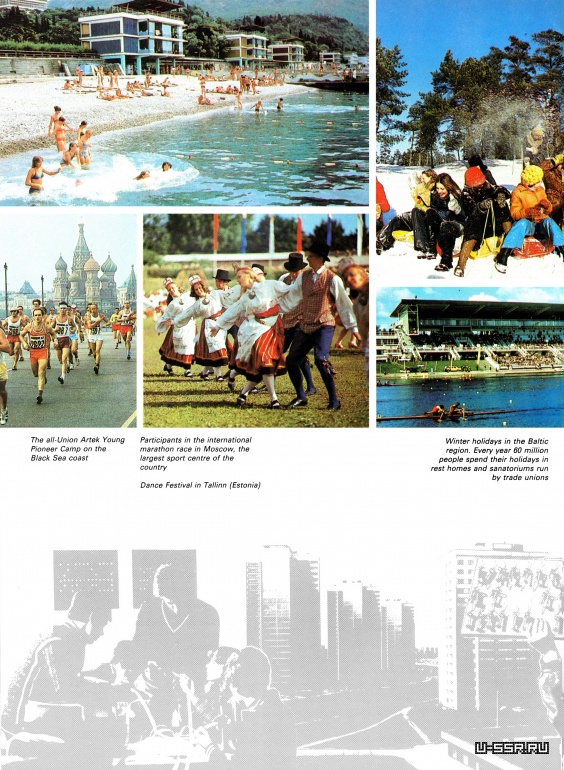
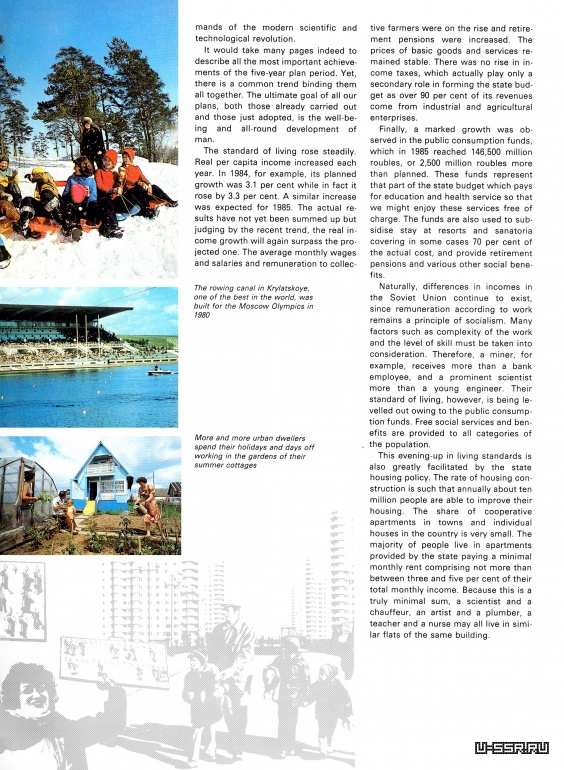
mands of the modern scientific and technological revolution.
It would take many pages indeed to describe all the most important achievements of the five-year plan period. Yet, there is a common trend binding them all together. The ultimate goal of all our plans, both those already carried out and those just adopted, is the well-being and all-round development of man.
The standard of living rose steadily. Real per capita income increased each year. In 1984, for example, its planned growth was 3.1 per cent while in fact it rose by 3.3 per cent. A similar increase was expected for 1985. The actual results have not yet been summed up but judging by the recent trend, the real income growth will again surpass the projected one. The average monthly wages and salaries and remuneration to collective farmers were on the rise and retirement pensions were increased. The prices of basic goods and services remained stable. There was no rise in income taxes, which actually play only a secondary role in forming the state budget as over 90 per cent of its revenues come from industrial and agricultural enterprises.
Finally, a marked growth was observed in the public consumption funds, which in 1985 reached 146,500 million roubles, or 2,500 million roubles more than planned. These funds represent that part of the state budget which pays for education and health service so that we might enjoy these services free of charge. The funds are also used to subsidise stay at resorts and sanatoria covering in some cases 70 per cent of the actual cost, and provide retirement pensions and various other social benefits.
Naturally, differences in incomes in the Soviet Union continue to exist, since remuneration according to work remains a principle of socialism. Many factors such as complexity of the work and the level of skill must be taken into consideration. Therefore, a miner, for example, receives more than a bank employee, and a prominent scientist more than a young engineer. Their standard of living, however, is being levelled out owing to the public consumption funds. Free social services and benefits are provided to all categories of the population.
This evening-up in living standards is also greatly facilitated by the state housing policy. The rate of housing construction is such that annually about ten million people are able to improve their housing. The share of cooperative apartments in towns and individual houses in the country is very small. The majority of people live in apartments provided by the state paying a minimal monthly rent comprising not more than between three and five per cent of their total monthly income. Because this is a truly minimal sum, a scientist and a chauffeur, an artist and a plumber, a teacher and a nurse may all live in similar flats of the same building.
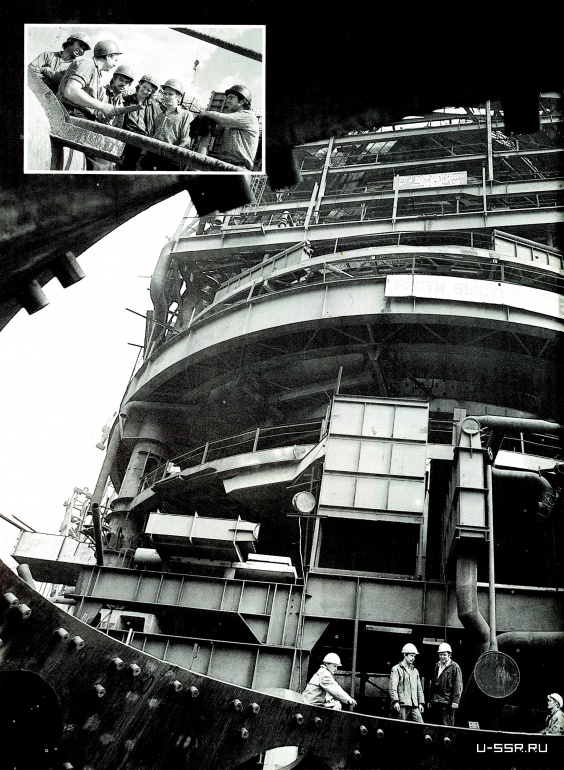
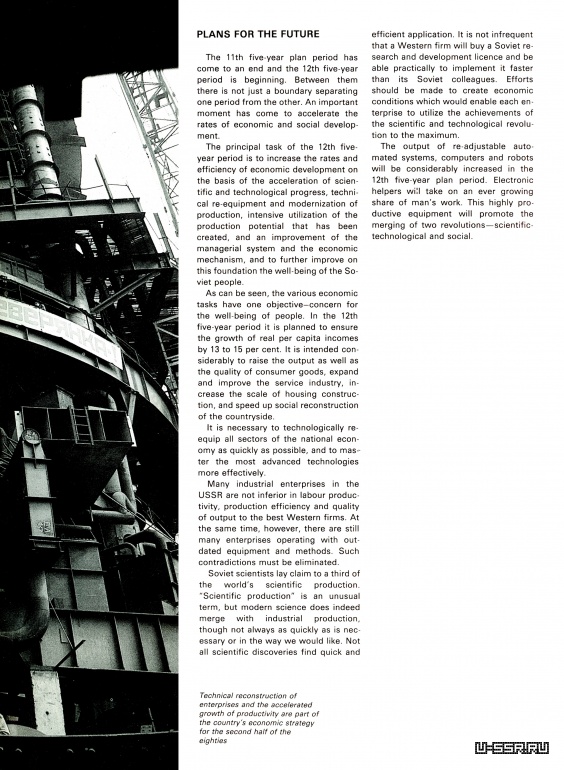
PLANS FOR THE FUTURE
The 11th five-year plan period has come to an end and the 12th five-year period is beginning. Between them there is not just a boundary separating one period from the other. An important moment has come to accelerate the rates of economic and social development.The principal task of the 12th five-year period is to increase the rates and efficiency of economic development on the basis of the acceleration of scientific and technological progress, technical re-equipment and modernization of production, intensive utilization of the production potential that has been created, and an improvement of the managerial system and the economic mechanism, and to further improve on this foundation the well-being of the Soviet people.
As can be seen, the various economic tasks have one objective-concern for the well-being of people. In the 12th five-year period it is planned to ensure the growth of real per capita incomes by 13 to 15 per cent. It is intended considerably to raise the output as well as the quality of consumer goods, expand and improve the service industry, increase the scale of housing construction, and speed up social reconstruction of the countryside.
It is necessary to technologically reequip all sectors of the national economy as quickly as possible, and to mas-' ter the most advanced technologies more effectively.
Many industrial enterprises in the USSR are not inferior in labour productivity, production efficiency and quality of output to the best Western firms. At the same time, however, there are still many enterprises operating with outdated equipment and methods. Such contradictions must be eliminated.
Soviet scientists lay claim to a third of the world's scientific production. "Scientific production" is an unusual term, but modern science does indeed merge with industrial production, though not always as quickly as is necessary or in the way we would like. Not all scientific discoveries find quick and
efficient application. It is not infrequent that a Western firm will buy a Soviet research and development licence and be able practically to implement it faster than its Soviet colleagues. Efforts should be made to create economic conditions which would enable each enterprise to utilize the achievements of the scientific and technological revolution to the maximum.
The output of re-adjustable automated systems, computers and robots will be considerably increased in the 12th five-year plan period. Electronic helpers will take on an ever growing share of man's work. This highly productive equipment will promote the merging of two revolutions—scientific-technological and social.
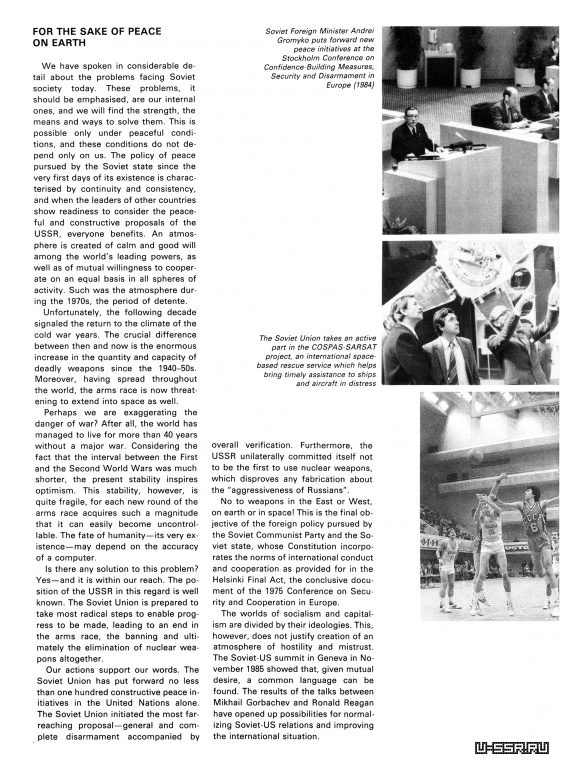
FOR THE SAKE OF PEACE ON EARTH
We have spoken in considerable detail about the problems facing Soviet society today. These problems, it should be emphasised, are our internal ones, and we will find the strength, the means and ways to solve them. This is possible only under peaceful conditions, and these conditions do not depend only on us. The policy of peace pursued by the Soviet state since the very first days of its existence is characterised by continuity and consistency, and when the leaders of other countries show readiness to consider the peaceful and constructive proposals of the USSR, everyone benefits. An atmosphere is created of calm and good will among the world's leading powers, as well as of mutual willingness to cooperate on an equal basis in all spheres of activity. Such was the atmosphere during the 1970s, the period of detente.Unfortunately, the following decade signaled the return to the climate of the cold war years. The crucial difference between then and now is the enormous increase in the quantity and capacity of deadly weapons since the 1940-50s. Moreover, having spread throughout the world, the arms race is now threatening to extend into space as well.
Perhaps we are exaggerating the danger of war? After all, the world has managed to live for more than 40 years without a major war. Considering the fact that the interval between the First and the Second World Wars was much shorter, the present stability inspires optimism. This stability, however, is quite fragile, for each new round of the arms race acquires such a magnitude that it can easily become uncontrollable. The fate of humanity—its very existence-may depend on the accuracy of a computer.
Is there any solution to this problem? Yes—and it is within our reach. The position of the USSR in this regard is well known. The Soviet Union is prepared to take most radical steps to enable progress to be made, leading to an end in the arms race, the banning and ultimately the elimination of nuclear weapons altogether.
Our actions support our words. The Soviet Union has put forward no less than one hundred constructive peace initiatives in the United Nations alone. The Soviet Union initiated the most far-reaching proposal—general and complete disarmament accompanied by overall verification. Furthermore, the USSR unilaterally committed itself not to be the first to use nuclear weapons, which disproves any fabrication about the "aggressiveness of Russians".
No to weapons in the East or West, on earth or in space! This is the final objective of the foreign policy pursued by the Soviet Communist Party and the Soviet state, whose Constitution incorporates the norms of international conduct and cooperation as provided for in the Helsinki Final Act, the conclusive document of the 1975 Conference on Security and Cooperation in Europe.
The worlds of socialism and capitalism are divided by their ideologies. This, however, does not justify creation of an atmosphere of hostility and mistrust. The Soviet-US summit in Geneva in November 1985 showed that, given mutual desire, a common language can be found. The results of the talks between Mikhail Gorbachev and Ronald Reagan have opened up possibilities for normalizing Soviet-US relations and improving the international situation.
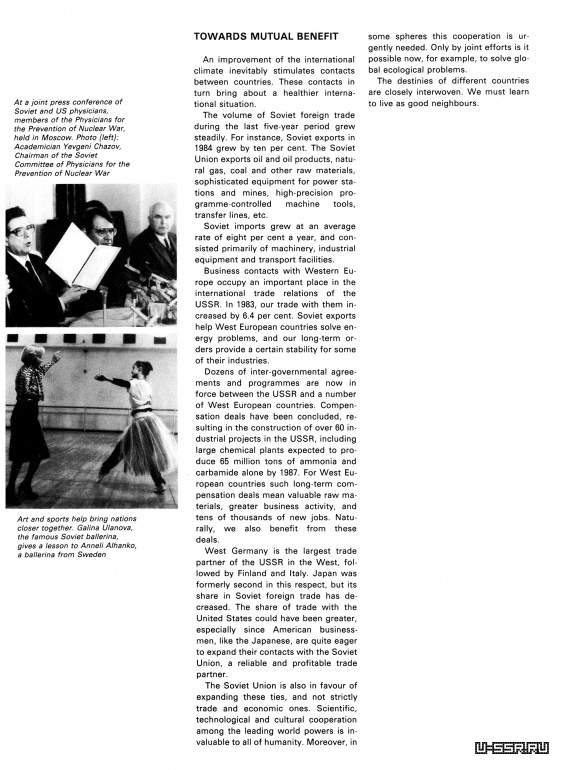
TOWARDS MUTUAL BENEFIT
An improvement of the international climate inevitably stimulates contacts between countries. These contacts in turn bring about a healthier international situation.The volume of Soviet foreign trade during the last five-year period grew steadily. For instance, Soviet exports in 1984 grew by ten per cent. The Soviet Union exports oil and oil products, natural gas, coal and other raw materials, sophisticated equipment for power stations and mines, high-precision programme-controlled machine tools, transfer lines, etc.
Soviet imports grew at an average rate of eight per cent a year, and consisted primarily of machinery, industrial equipment and transport facilities.
Business contacts with Western Europe occupy an important place in the international trade relations of the USSR. In 1983, our trade with them increased by 6.4 per cent. Soviet exports help West European countries solve energy problems, and our long-term orders provide a certain stability for some of their industries.
Dozens of inter governmental agreements and programmes are now in force between the USSR and a number of West European countries. Compensation deals have been concluded, resulting in the construction of over 60 industrial projects in the USSR, including large chemical plants expected to produce 65 million tons of ammonia and carbamide alone by 1987. For West European countries such long-term compensation deals mean valuable raw materials, greater business activity, and tens of thousands of new jobs. Naturally, we also benefit from these deals.
West Germany is the largest trade partner of the USSR in the West, followed by Finland and Italy. Japan was formerly second in this respect, but its share in Soviet foreign trade has decreased. The share of trade with the United States could have been greater, especially since American businessmen, like the Japanese, are quite eager to expand their contacts with the Soviet Union, a reliable and profitable trade partner.
The Soviet Union is also in favour of expanding these ties, and not strictly trade and economic ones. Scientific, technological and cultural cooperation among the leading world powers is invaluable to all of humanity. Moreover, in some spheres this cooperation is urgently needed. Only by joint efforts is it possible now, for example, to solve global ecological problems.
The destinies of different countries are closely interwoven. We must learn to live as good neighbours.
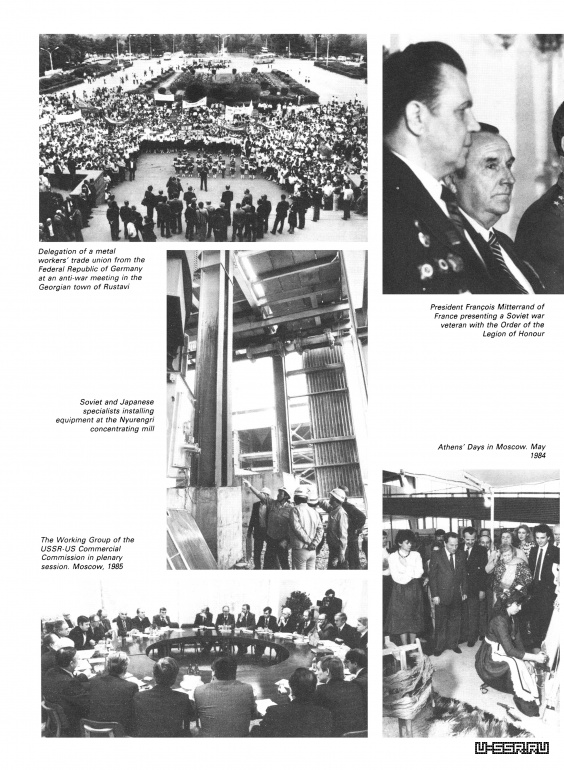
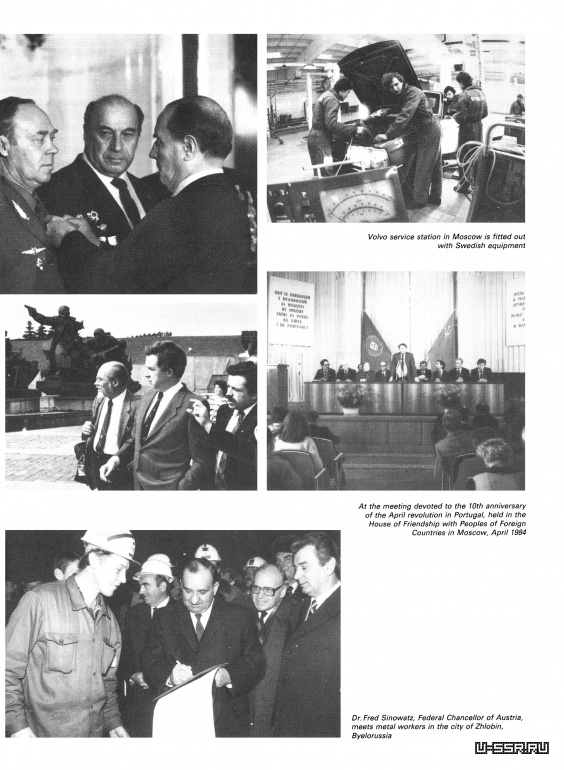
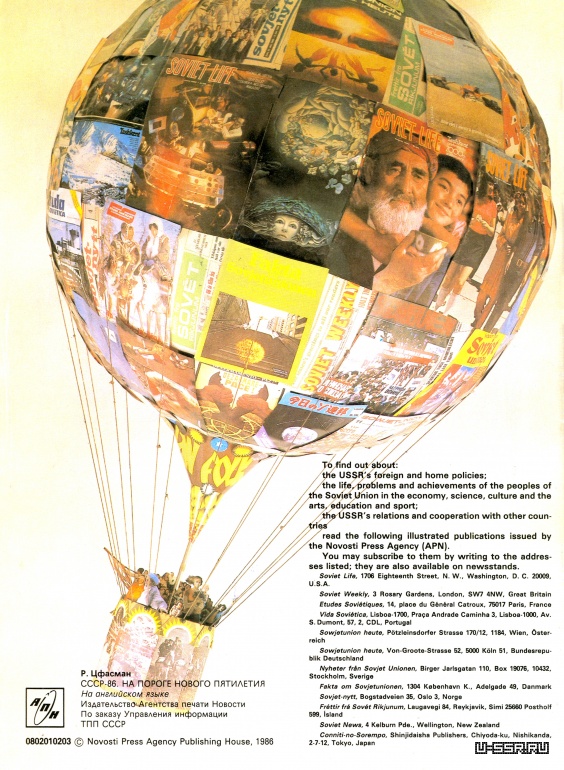
Р.Цфасман
СССР-1986. На пороге нового пятилетия
На английском языке
Издательство Агентства печати Новости, 1986


